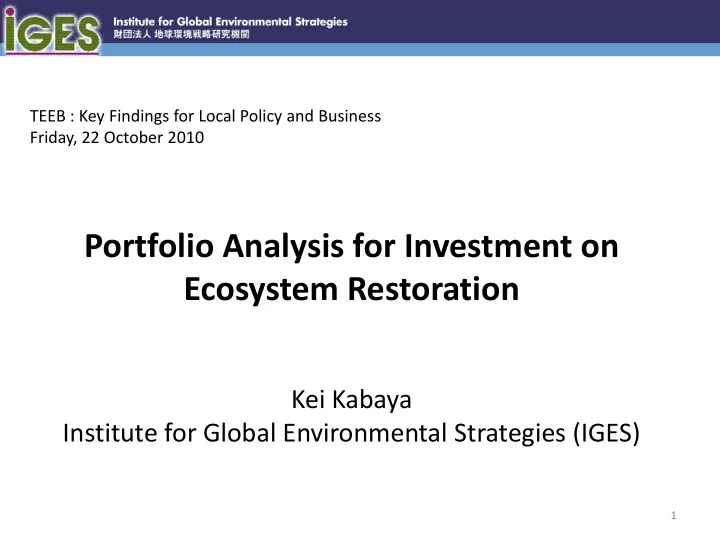

TEEB : Key Findings for Local Policy and Business Friday, 22 October 2010 Portfolio Analysis for Investment on Ecosystem Restoration Kei Kabaya Institute for Global Environmental Strategies (IGES) 1
Investment on Ecosystem and Modern Portfolio Theory Investment on ecosystem restoration Current status of ecosystem degradation (Millennium Ecosystem Assessment, 2005) e.g. 20% of global coral reef disappeared during the last few decades Ecosystem degradation implies the loss of natural assets Investment on natural capital for conservation or restoration attracts global attention Modern portfolio theory Theory of investment allocation for better expected return and lower risk Efficient frontier Efficient frontier : collection of portfolios for the lowest risk for a given level of expected return or vice versa Best possible CAL Expected return Capital allocation line (CAL) : Market portfolio possible combination of risky and risk-free assets → its slope represents the Sharpe ratio ; measure of the excess return per unit of risk Market portfolio : portfolio of risky assets for highest Sharpe ratio Risk free rate Volatility (Risk) 2
Simulation Scenario & Data Simulation scenario Investment on restoration projects for the following 7 ecosystems Funding resource may come from the global fund, domestic public investment or private stocks Investigation of the market portfolio and prioritization from the economic viewpoint Implication for local policies and business Simulation data Inland Tropical Temperate Coral reef Coastal wetland Freshwater Grassland forest forest Min. value 14 248 981 1,779 91 30 297 (US$/ha/yr) Max. value 1,195,478 79,580 44,597 13,488 23,222 4,863 3,091 (US$/ha/yr) Min. restoration 452,083 193,917 11,371 3,333 1,032 566 143 cost (US$/ha) Max. restoration 15,949,758 431,563 33,944 188,497 22,213 3,190 1,377 cost (US$/ha) Annual average -2.98 -2.70 2.64 -2.95 2.88 3.32 5.15 return (%) Standard 2.95 2.23 2.10 2.31 2.93 2.57 2.13 deviation (%) Value and cost data come from the TEEB D0 Appendix C + Climate Issues Update at the global level 3
Simulation Results Return Maximum Sharpe ratio : 2.373 5.00% 3.00% Sensitivity analysis 1.00% Sharpe ratio 2.900 Volatility 0.00% 1.00% 2.00% 3.00% -1.00% 2.700 -3.00% 2.500 <Market portfolio> 2.300 Coral reef 0% Coastal 0% 2.100 Inland wetland 20% Freshwater 0% 1.900 -20% -10% 0% 10% 20% Tropical forest 10% Return Inland wetland Return Tropical forest Temperate forest 20% Return Temperate forest Return Grassland S.D. Inland wetland S.D. Tropical forest Grassland 50% S.D. Temperate forest S.D. Grassland 4
Implication for local policy and business Implication for local policy Implication for business • Investment on ecosystem restoration will be economically efficient once the • Some ecosystems (coral reefs, coastal economic value of ecosystem services are area, and freshwater) may not be covered recognized within the market by the market portfolio due to their low expected return • Investment priority for inland wetland, → Local governments may need to tropical forest, temperate forest and support or complement ecosystem grassland will be comparatively high from restoration through public investment the economic viewpoint • Firmly established economic valuation of • Some financial derivatives relevant to ecosystem services will lower the risk of ecosystem restoration can be developed portfolio, subsequently achieve better on condition of further valuation and Sharpe ratio analysis → Local specific valuation may contribute to attract private investment on local • A new financial mechanism such as GDM ecosystem restoration may consider the possibility of portfolio (e.g. GDM portfolio) 5
TEEB : key findings for Local Policy and Business Friday, 22 October 2010 Thank you for your attention Institute for Global Environmental Strategies (IGES) http://www.iges.or.jp 6
Recommend
More recommend